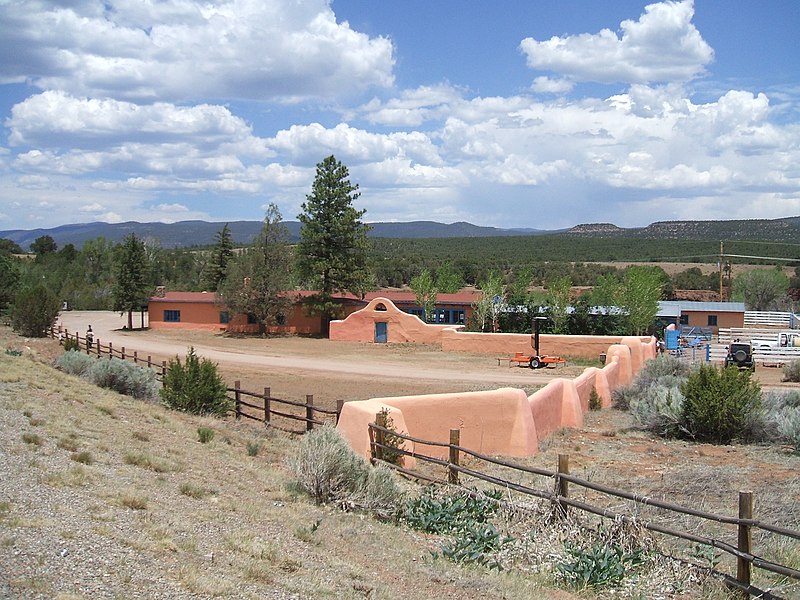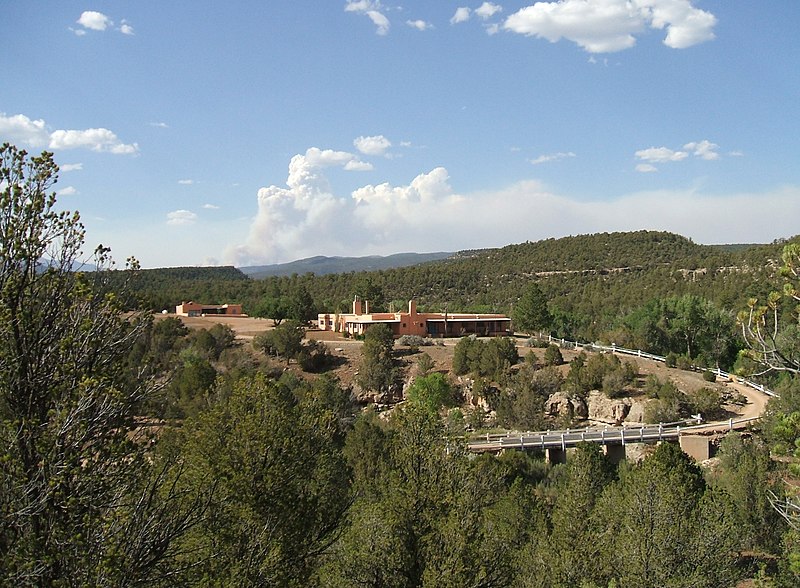 Pecos National Historical Park is located near Pecos, New Mexico. The park protects the National Historic Landmark site which is composed of the ruins of an ancient pueblo and a mission church.
Pecos National Historical Park is located near Pecos, New Mexico. The park protects the National Historic Landmark site which is composed of the ruins of an ancient pueblo and a mission church.
Getting There
Albuquerque, New Mexico has a major airport, so our road trip will begin there. Drive time between Albuquerque and Pecos National Historical Park: 1.25 hours.
⇒From Albuquerque, take I-25 north to Glorieta, New Mexico. At Glorieta, take Highway 50 to the town of Pecos. Proceed through Pecos on Main Street (Highway 63) and follow the signs to the park.
Bonus stop: Santa Fe, New Mexico. The capital city of New Mexico is not only beautiful, but it is also the second oldest city in the US. We enjoy visiting Santa Fe for its colorful history, outstanding art, and fabulous food. The natural beauty of the surrounding Sangre de Cristo Mountains and the Santa Fe National Forest just enhances the city’s appeal.

Things to do in Santa Fe:
- Santa Fe Plaza
- Palace of the Governors
- Loretto Chapel
- San Miguel Chapel
- Cathedral Basilica of St. Francis of Assisi
- Georgia O’Keeffe Museum
- Canyon Road art galleries
- Santa Fe Railyard
- Meow Wolf

Now let’s continue on to Pecos National Historical Park…
Destination: Pecos National Historical Park
 Website link: Pecos National Historical Park
Website link: Pecos National Historical Park
Park features:
- Visitor center, museum, giftshop
- Two picnic areas
- Three hiking trails
- Fishing (reservation required)
- Wildlife viewing
- Scheduled ranger-guided tours
We recommend stopping first at the visitor center to get information, pick up a trail map, and view a short film about the park. The outstanding museum is one of the best we have seen at any park, so allow time to view the exhibits.

Ancestral Sites Trail
Ancestral Sites Trail is the most popular trail in the park and takes visitors on a 1.25-mile loop through the pueblo ruins and the mission church. Most visitors choose to do the self-guided tour; however, some ranger-guided tours may be offered. Plan to spend at least an hour walking the trail and longer if you’re like us and take a lot of pictures.

The trail guide and wayside information boards ensure that visitors get a comprehensive overview of where the pueblo buildings stood. There were actually two pueblos on the site – a north and south. Evidence shows that the site has been occupied since 11,500 BCE, though the first pueblo buildings, which were made of rocks and mud, were constructed around 1100 CE. The last buildings were four to five stories tall and were occupied by up to 2,000 people.

Native people occupied Pecos Pueblo (known historically as Cicuye) until 1838 when the last occupants moved to Jemez Pueblo where the people spoke the same Towa language. Jemez Pueblo, which is still occupied as a thriving community, is located approximately 59 miles west of Pecos. Towa is still spoken by the Jemez people, though there is no traditional written form of the language due to tribal regulations that prohibit transcription.
Pecos Mission Church

Franciscan missionaries arrived in the area in 1617 and built the first mission church, but it was too far from the pueblo to interest the residents. A second mission consisting of a church and Convento (storage rooms and living quarters for residents of the mission) was built on the site of the current mission church in 1625. As with most Spanish missions in the Southwestern US, the missionaries oversaw the construction, but the native people provided the slave labor.

Disgruntled with the missionaries’ mistreatment of their people and disrespect of traditional native religious practices, the Pecos people joined thirty other pueblos in a revolt against the Spanish government. During the revolt, referred to as the Pueblo Revolt of 1680, the Pecos Mission Church and Convento were destroyed. The Pueblo Revolt was successful in driving the Spanish missionaries and settlers out of the area. However, the Spanish returned to claim what is now New Mexico twelve years later. This was due to fears that the French, who were making their way west of the Mississippi River, would get there first.

The current Mission Church was completed in 1717, and interestingly, missionaries did convert some pueblo people to Christianity. However, the Puebloans never did fully give up their traditional ceremonies and religious practices. Jemez people continue those traditions today, and Pecos Pueblo endures as a sacred site.
The Battle of Glorieta Pass

The Battle of Glorieta Pass is perhaps one of the lesser-known Civil War Battles, but it ended in an important victory for Union Troops and the Northern New Mexico Territory. Here’s an excerpt from the National Park Service:
“Although many associate the Civil War with eastern battlefields like Antietam or the Wilderness, the fight over slavery in the United States extended much further west. In March of 1862, the war brought a battle to Glorieta Pass. Some refer to the battle as the Gettysburg of the West due to its overall significance to the war. The Confederates campaigned to take control of the West, which would have greatly improved their chances of success. However, in just three days of tough fighting, the Union Army ruined the Confederate plans and sent them retreating back southwards.”
For additional information about the battle, click here: Battle of Glorieta Pass
The park maintains the 2.25-mile Glorieta Battlefield Trail. Those who want to hike this trail will need to check in at the visitor center to purchase a trail guide and obtain a gate code. The trailhead is a 7.5-mile drive from the visitor center.
Forked Lightning Ranch
 Our visit to Pecos National Historical Park unfortunately did not take place on a day when they were offering tours of the Forked Lightning Ranch. Perhaps we will go back one day to take the tour because the ranch has a colorful past that includes a rodeo legend as well as some Hollywood royalty!
Our visit to Pecos National Historical Park unfortunately did not take place on a day when they were offering tours of the Forked Lightning Ranch. Perhaps we will go back one day to take the tour because the ranch has a colorful past that includes a rodeo legend as well as some Hollywood royalty!

Tex Austin
The original ranch was established by rodeo promoter Tex Austin in 1925 after he purchased 5,500 acres of land near the banks of the Pecos River. Austin operated a dude ranch on the site for several years, hosting only elite guests such as Charles Lindbergh and Will Rogers. Unfortunately, with the onset of the Great Depression, Austin and the ranch fell into bankruptcy. Other owners held the ranch for a few years but lived in the old Kozlowki’s Trading Post rather than in the ranch house.

Buddy Fogelson
Buddy Fogelson, a Texas rancher and oilman, purchased the property in 1941. He married Hollywood actress Greer Garson in 1949, and they made the working cattle ranch their home. The couple hosted lavish parties and skeet shoots, making the ranch a gathering place for their celebrity friends. Upon Buddy’s death in 1987, a portion of the ranch, including the house, was left to his wife, Greer, and a separate portion called Los Trigos Ranch was left to his nephew. Greer sold her land to The Conservation Fund in 1991. The fund then donated the property to enlarge what would later become the Pecos National Historical Park. The nephew’s parcels were sold to private purchasers.
For additional information click here: Forked Lightning Ranch
Bonus side trip:
Fort Union National Monument. From Pecos, take I-25 north to Watrous via Las Vegas, New Mexico, then take Highway 161 north 12 miles to the park. Driving distance between Pecos National Historical Park and Fort Union National Monument: 1 hour.  Thank you for joining us on our road trip to Pecos National Historical Park! We hope we have inspired your wanderlust. Leave us a comment below and tell us about your own journeys. We would love to hear from you.
Thank you for joining us on our road trip to Pecos National Historical Park! We hope we have inspired your wanderlust. Leave us a comment below and tell us about your own journeys. We would love to hear from you.
Need more road trip inspiration? Click on these exciting national park sites:
Colorado National Monument
Harpers Ferry National Historical Park
Craters of the Moon National Monument
Mike and Kellye

As always, we strive to be as accurate with our information as possible. If we made a mistake, it was unintentional. (Hey, we’re only human!) Our opinions are our own. ©2022
Forked Lightning Ranch photo credits: Chris English, Wikimedia Commons.

